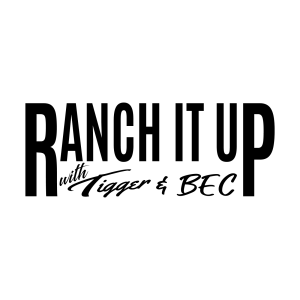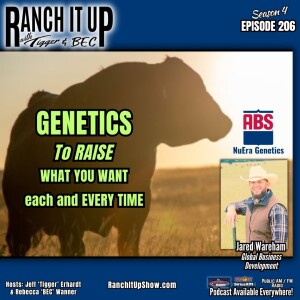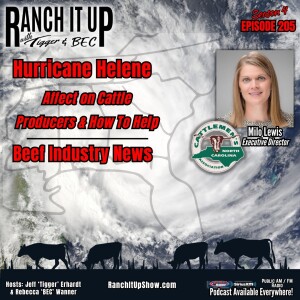We tackle a whole pile of topics from program cattle to the beef checkoff to alternative meat. Plus updates on feeder cattle sales, beef export information and so much more on this all new episode of the Ranch It Up Radio Show. Be sure to subscribe on your favorite podcasting app or on the Ranch It Up Radio Show YouTube Channel.
EPISODE 204 DETAILS
Program Cattle, Beef Checkoff, Beef Industry News
Cattle Buyers Continue To Recommend Program Feeder Cattle
Program Feeder Cattle, Buying & Selling Tips
Many buyers are recommending that those producers that are enrolling in various programs to assist in marketing feeder cattle need to continue with those programs because they could be setting the benchmark of prices in the future. Mike Bolinger with Superior Livestock joins us again discussing program cattle, his thoughts on the Beef Checkoff and other various industry topics.
Latest Beef Checkoff & Industry News
Export Federation Warns Of Port Strike Impacts Of Beef
Exports are heavily dependent on the Eastern ports threatened by an Oct. 1 strike deadline, but the ramifications of a halt in shipments would be serious for beef and pork industries, too, the U.S. Meat Export Federation warned late last week.
USMEF President and CEO Dan Halstrom said, “The three big West Coast ports are the leading outlets for U.S. beef and pork exports. That doesn’t mean the East and Gulf coast isn’t important. If we look at total waterborne exports of pork, about 45% of those go through the East and Gulf coast ports, and beef side about 30% of the waterborne exports.”
He pointed in particular to “quite a high percentage of very high value chilled beef that goes out from the East Coast in particular for destinations like Europe and the Middle East. He said we can’t overstate the importance of the East Coast and Gulf Coast ports. Even though the West Coast is larger, still a very significant quantity is exported through the East and Gulf coasts.
Halstrom said any halt in port activity “will back up the supply chain immediately,: and redirecting meat exports to the West Coast is “by no means a long-term solution at all,” because a vast flow of grain and non-farm commodities and goods would also be left without port capacity. He said we’re challenged to export all of our products today using all the ports, so we cannot afford a shutdown in any part of the supply chain.
Plant Based Diets Are More Expensive
Originally posted in Alt-Meat and then again in MeatlingPlace.Com, consuming a plant-based diet that is nutritionally equivalent to one that includes animal proteins is “considerably” (34% to 45%) more expensive than an omnivorous diet, putting numbers to one complaint that’s been voiced about plant-based diets for years, according to new research from New Zealand’s Massey University.
As published in the journal “Frontiers in Nutrition,” the article reviews recent modeling studies using Linear Programming to determine the respective roles of animal- and plant-sourced foods in developing a least-cost diet in the United States and New Zealand.
The abstract said that “In both economies, least-cost diets were found to include animal-based foods, such as milk, eggs, fish and seafood, to meet the energy and nutrient requirements of healthy adults at the lowest retail cost.
The article said , the costliest culprits in transitioning from an animal- and plant-containing least-cost diet to a plant-only based least-cost diet are mostly vitamins and minerals.
In conclusion, “Modeling of least-cost diets that consist exclusively of plant-based foods is feasible, but at a higher daily diet cost, and these diets are often close to limiting several key nutrients.
2024 Stockmanship & Stewardship Tour, Hamburg, New York
The Stockmanship & Stewardship Tour is coming to Hamburg, New York and surrounding states October 25 - 26 at the Agriculture Discovery Center In Hamburg, New York. Participants will explore a range of informative topics such as carcass quality, grazing management, consumer insights, and more, all designed to elevate your operations and boost profitability. Highlights include Beef On Dairy, Cattle Handling Demonstrations, A Grazing Workshop, A Consumer Insights Workshop, and BQA Transportation Information.
Fresno, California is another stop on the Stockmanship & Stewardship Tour. The dates are October 18 - 19. We have the agenda’s, where to register, and how to get involved with the virtual tour November 7th in the show notes at ranch it up show dot com.
Stockmanship & Stewardship Tour Agendas and Registration, click HERE.
Select Sires Fall Beef Sire Directory Available
The Select Sires Fall Beef Sire Directory is now available online for viewing. Exciting new sires to the lineup in Angus, Simmental, and Red Angus just to name a few. The link for the digital copy of the directory is online at ranch it up show dot com for your convenience or head to SelectSires.Com. Fall Beef Sire Directory, click HERE.
Foundation Female Program From Dakota Community Bank
A great program allowing young people a start in the beef business. The Foundation Female Program from Dakota Community Bank was established to award recipients with an interest free loan to purchase 5 bred heifers and assist youth in establishing their own cattle herd. With this particular program applications will be accepted from youth currently enrolled in 7th and 8th grade and at least 13 years of age by the application deadline and must reside within a 100 mile radius of any Dakota Community Bank & Trust. This is just an example of some of the great programs that exist in Rural America helping the next generation get into the business. Check in your area, there may just be similar programs. And yes I checked already, I am too old to apply.
Northern Livestock Video Auction Sale Report
Northern Livestock Video Auction in Billings, MT recently hosted a tremendous set of feeder and stocker cattle at their annual Fall Premier Sale. For a complete sale report, click HERE.
RanchChannel.Com Now Has The Futures Markets
Futures Markets
RanchChannel.com now has futures markets at your fingertips! Feeder Cattle, Live Cattle, Corn, Wheat, Soybeans, Soybean Oil, Milk Class IV, and Ethanol. Information is provided by DTN and market information may be delayed by as much as 10 minutes. Click Here for more information!
UPCOMING SALES & EVENTS
ISA Beefmasters: October 5, 2024, San Angelo, Texas
JYJ Red Angus: November 9, 2024, Columbia, Alabama
Clear Springs Cattle Company: November, 20, 2024, Starbuck, MN
World Famous Miles City Bucking Horse Sale: May 15 - 18, 2025
BULL SALE REPORT & RESULTS
Churchill Cattle Company
Van Newkirk Herefords
Gardiner Angus Ranch
Cow Camp Ranch
Jungels Shorthorn Farms
Ellingson Angus
Edgar Brothers Angus
Schaff Angus Valley
Prairie Hills Gelbvieh
Clear Springs Cattle Company
CK Cattle
Mrnak Hereford Ranch
Frey Angus Ranch
Hoffmann Angus Farms
Topp Herefords
River Creek Farms
Upstream Ranch
Gustin’s Diamond D Gelbvieh
Schiefelbein Farms
Wasem Red Angus
Raven Angus
Krebs Ranch
Yon Family Farms
Chestnut Angus
Eichacker Simmentals & JK Angus
Windy Creek Cattle Company
Pedersen Broken Heart Ranch
Mar Mac Farms
Warner Beef Genetics
Arda Farms & Freeway Angus
Leland Red Angus & Koester Red Angus
Fast - Dohrmann - Strommen
RBM Livestock
Weber Land & Cattle
Sundsbak Farms
Hidden Angus
Wheatland Cattle Company
Miller Angus Farms
L 83 Ranch
U2 Ranch
Vollmer Angus Ranch
A & B Cattle
Carter Angus Farms
Roller Ranch
Montgomery Ranch
Jorgensen Farms
DLCC Ranch
Four Hill Farm North Country Angus Alliance
Spruce Hill Ranch
Wilson Angus
Jorgensen Land & Cattle Motherlode Sale
FEATURING
Mike Bolinger
Superior Livestock
https://superiorlivestock.com/
@SuperiorLivestockAuction
Kirk Donsbach: Stone X Financial
https://www.stonex.com/
@StoneXGroupInc
Mark Vanzee
Livestock Market, Equine Market, Auction Time
https://www.auctiontime.com/
https://www.livestockmarket.com/
https://www.equinemarket.com/
@LivestockMkt
@EquineMkt
@AuctionTime
Shaye Koester
Casual Cattle Conversation
https://www.casualcattleconversations.com/
@cattleconvos
Questions & Concerns From The Field?
Call or Text your questions, or comments to 707-RANCH20 or 707-726-2420
Or email RanchItUpShow@gmail.com
FOLLOW Facebook/Instagram: @RanchItUpShow
SUBSCRIBE to the Ranch It Up YouTube Channel: @ranchitup
Website: RanchItUpShow.com
https://ranchitupshow.com/
The Ranch It Up Podcast is available on ALL podcasting apps.
https://ranchitup.podbean.com/
Rural America is center-stage on this outfit.
AND how is that? Tigger & BEC Live This Western American Lifestyle.
Tigger & BEC represent the Working Ranch world and cattle industry by providing the cowboys, cowgirls, beef cattle producers & successful farmers the knowledge and education needed to bring high-quality beef & meat to your table for dinner.
Learn more about Jeff 'Tigger' Erhardt & Rebecca Wanner aka BEC here: TiggerandBEC.com
https://tiggerandbec.com/
#RanchItUp #StayRanchy #TiggerApproved #tiggerandbec #rodeo #ranching #farming
References
https://www.stonex.com/
https://www.livestockmarket.com/
https://www.equinemarket.com/
https://www.auctiontime.com/
https://gelbvieh.org/
https://www.imogeneingredients.com/
https://alliedgeneticresources.com/
https://westwayfeed.com/
https://medoraboot.com/
http://www.gostockmens.com/
https://www.imiglobal.com/beef
https://www.tsln.com/
https://transova.com/
https://axiota.com/
https://axiota.com/multimin-90-product-label/
https://jorgensenfarms.com/
https://ranchchannel.com/
https://www.wrangler.com/
https://www.ruralradio147.com/
https://www.rfdtv.com/
https://www.meatingplace.com/Industry/News/Details/116137
https://www.meatingplace.com/Industry/News/Details/116139
https://www.stockmanshipandstewardship.org/
https://www.selectsires.com/
https://issuu.com/selectsiresbeef/docs/2024_fall_sire_directory-final_single_page
https://www.northernlivestockvideo.com/catalog-list/?saleid=1519















